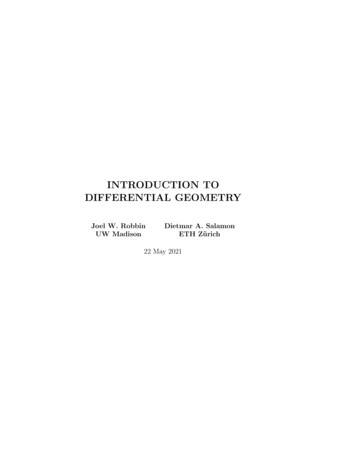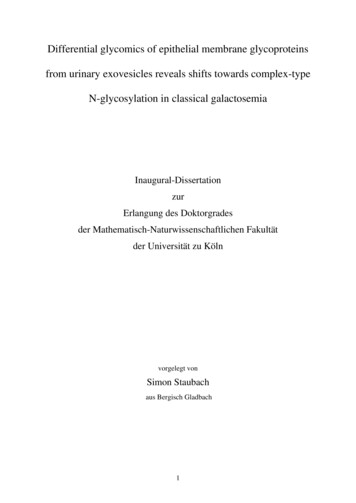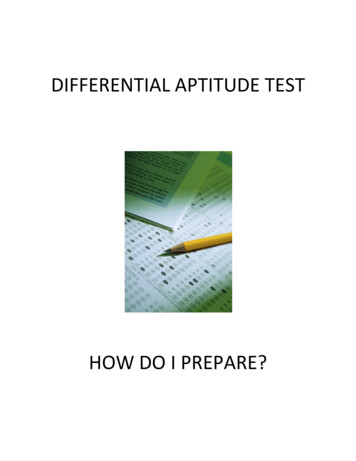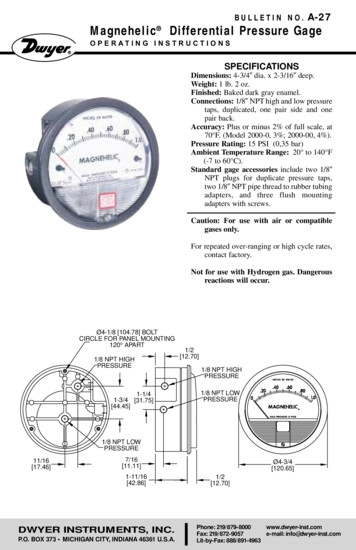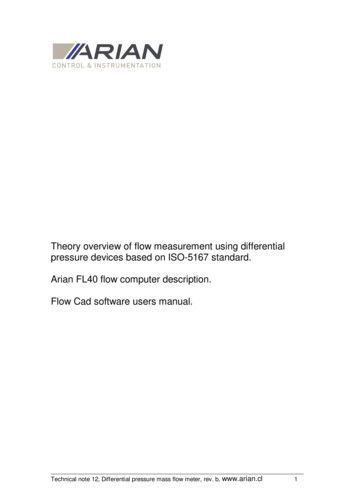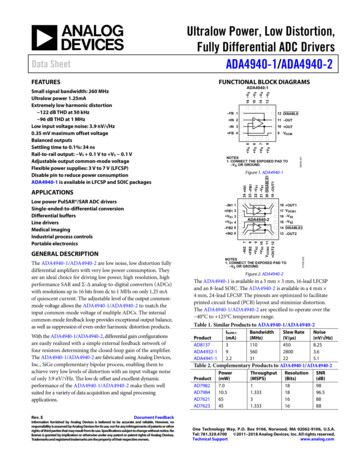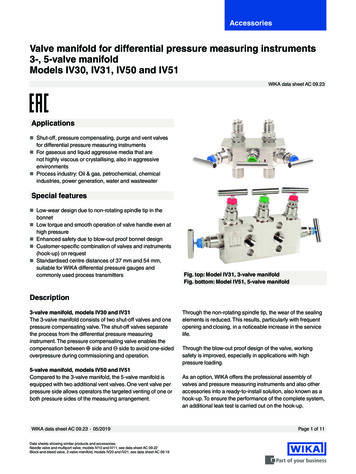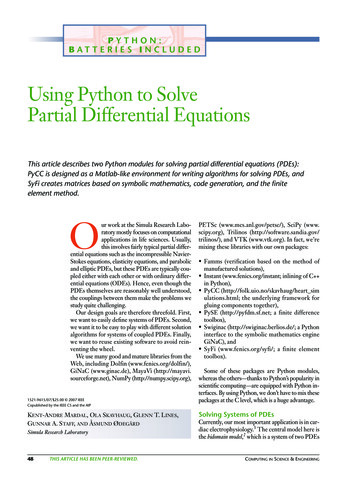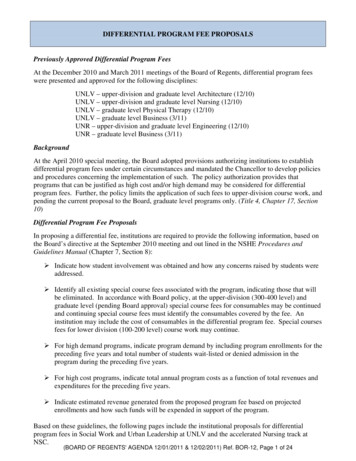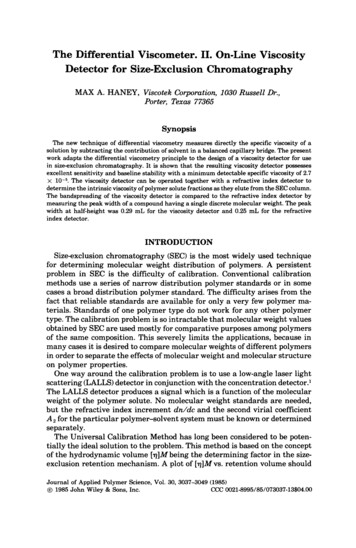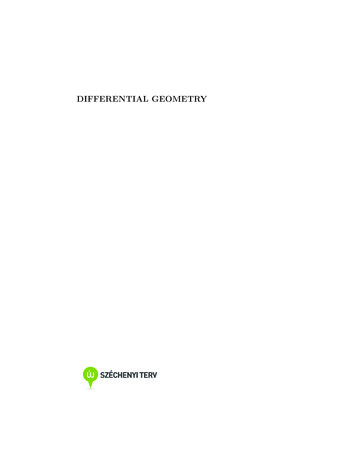
Transcription
DIFFERENTIAL GEOMETRY
Series of Lecture Notes and Workbooks for TeachingUndergraduate MathematicsAlgoritmuselméletAlgoritmusok bonyolultságaAnalitikus módszerek a pénzügyekbenBevezetés az analı́zisbeDifferential GeometryDiszkrét optimalizálásDiszkrét matematikai feladatokGeometriaIgazságos elosztásokInteraktı́v analı́zis feladatgyűjtemény matematika BSc hallgatók számáraIntroductory Course in AnalysisMatematikai pénzügyMathematical Analysis-Exercises 1-2Mértékelmélet és dinamikus programozásNumerikus �ciókutatási példatárOptimális irányı́tásokParciális differenciálegyenletekPéldatár az analı́zishezSzimmetrikus kombinatorikai struktúrákTöbbváltozós adatelemzés
Balázs CsikósDIFFERENTIALGEOMETRYEötvös Loránd UniversityFaculty of ScienceTypotex2014
2014–2019, Balázs Csikós,Eötvös Loránd University, Faculty of ScienceReferee: Árpád KurusaCreative Commons NonCommercial-NoDerivs 3.0 (CC BY-NC-ND 3.0)This work can be reproduced, circulated, published and performed for noncommercial purposes without restriction by indicating the author’s name, butit cannot be modified.ISBN 978 963 279 221 7Prepared under the editorship of Typotex Publishing House(http://www.typotex.hu)Responsible manager: Zsuzsa VotiskyTechnical editor: József GernerMade within the framework of the project Nr. TÁMOP-4.1.2-08/2/A/KMR2009-0045, entitled “Jegyzetek és példatárak a matematika egyetemi oktatásához” (Lecture Notes and Workbooks for Teaching Undergraduate Mathematics).KEY WORDS: Curve, Frenet frame, curvature, torsion, hypersurface, fundamental forms, principal curvature, Gaussian curvature, Minkowski curvature,manifold, tensor field, connection, geodesic curveSUMMARY: The aim of this textbook is to give an introduction to differential geometry. It is based on the lectures given by the author at EötvösLoránd University and at Budapest Semesters in Mathematics. In the firstchapter, some preliminary definitions and facts are collected, that will beused later. The classical roots of modern differential geometry are presentedin the next two chapters. Chapter 2 is devoted to the theory of curves,while Chapter 3 deals with hypersurfaces in the Euclidean space. In the lastchapter, differentiable manifolds are introduced and basic tools of analysis(differentiation and integration) on manifolds are presented. At the end ofChapter 4, these analytical techniques are applied to study the geometry ofRiemannian manifolds.
Contents1 Preliminaries1.1 Categories and Functors . . . . . . . . . . . . . . . . . . . .1.2 Linear Algebra . . . . . . . . . . . . . . . . . . . . . . . . .1.2.1 Linear Spaces and Linear Maps . . . . . . . . . . . .1.2.2 Determinant of Matrices and Linear Endomorphisms1.2.3 Orientation of a Linear Space . . . . . . . . . . . . .1.2.4 Tensor Product . . . . . . . . . . . . . . . . . . . . .1.2.5 Exterior Powers . . . . . . . . . . . . . . . . . . . . .1.2.6 Euclidean Linear Spaces . . . . . . . . . . . . . . . .1.2.7 Hodge Star Operator . . . . . . . . . . . . . . . . . .1.3 Geometry . . . . . . . . . . . . . . . . . . . . . . . . . . . .1.3.1 Affine Geometry . . . . . . . . . . . . . . . . . . . .1.3.2 Euclidean Spaces . . . . . . . . . . . . . . . . . . . .1.4 Topology . . . . . . . . . . . . . . . . . . . . . . . . . . . .1.4.1 Separation and Countability Axioms . . . . . . . . .1.4.2 Compactness . . . . . . . . . . . . . . . . . . . . . .1.4.3 Fundamental Group and Covering Spaces . . . . . .1.5 Multivariable Calculus . . . . . . . . . . . . . . . . . . . . .1.6 Measure and Integration . . . . . . . . . . . . . . . . . . . .1.7 Ordinary Differential Equations . . . . . . . . . . . . . . . .2 Curves in En2.1 The Notion of a Curve . . . . . . . . .2.2 The Length of a Curve . . . . . . . . .2.3 Crofton’s Formula . . . . . . . . . . .2.4 The Osculating k-planes . . . . . . . .2.5 Frenet Frames and Curvatures . . . .2.6 Limits of Some Geometrical Quantities2.7 Osculating Spheres . . . . . . . . . . .2.8 Plane Curves . . . . . . . . . . . . . .81. 81. 83. 86. 92. 97. 107. 112. 117i.11337111115213033334049565860626775
2.92.8.1 Evolute, Involute, Parallel Curves . . . . . . . . . . .2.8.2 The Rotation Number Theorem . . . . . . . . . . . .2.8.3 Convex Curves . . . . . . . . . . . . . . . . . . . . . .2.8.4 The Four Vertex Theorem . . . . . . . . . . . . . . . .Curves in R3 . . . . . . . . . . . . . . . . . . . . . . . . . . .2.9.1 Orthogonal Projections onto Planes Spanned by FrenetVectors . . . . . . . . . . . . . . . . . . . . . . . . . .2.9.2 Fenchel’s Theorem . . . . . . . . . . . . . . . . . . . .2.9.3 The Fáry-Milnor Theorem . . . . . . . . . . . . . . . .1181241271291311331351393 Hypersurfaces in Rn3.1 General Theory . . . . . . . . . . . . . . . . . . . . . . . . .3.1.1 Definition of a Parameterized Hypersurface . . . . .3.1.2 Curvature of Curves on a Hypersurface . . . . . . .3.1.3 The Weingarten Map and the Fundamental Forms .3.1.4 Umbilical Points . . . . . . . . . . . . . . . . . . . .3.1.5 The Fundamental Equations of Hypersurface Theory3.1.6 Surface Volume . . . . . . . . . . . . . . . . . . . . .3.2 Surfaces in R3 . . . . . . . . . . . . . . . . . . . . . . . . . .3.2.1 Surfaces of Revolution . . . . . . . . . . . . . . . . .3.2.2 Lines of Curvature, Triply Orthogonal Systems . . .3.2.3 Ruled and Developable Surfaces . . . . . . . . . . .3.2.4 Asymptotic Curves on Negatively Curved Surfaces .3.2.5 Surfaces of Constant Negative Curvature . . . . . .3.2.6 Minimal Surfaces . . . . . . . . . . . . . . . . . . . .1411411411431451511521611621621661731791831954 Manifolds4.1 Topological and Differentiable Manifolds . . . . . . . . . . .4.1.1 Basic Definitions . . . . . . . . . . . . . . . . . . . .4.1.2 Configuration Spaces . . . . . . . . . . . . . . . . . .4.1.3 Submanifolds of Rn . . . . . . . . . . . . . . . . . .4.1.4 Remarks on the Classification of Manifolds . . . . .4.2 The Tangent Bundle . . . . . . . . . . . . . . . . . . . . . .4.2.1 The Tangent Bundle . . . . . . . . . . . . . . . . . .4.2.2 The Derivative of a Smooth Map . . . . . . . . . . .4.3 The Lie Algebra of Vector Fields . . . . . . . . . . . . . . .4.3.1 The Lie Algebra of Lie Groups . . . . . . . . . . . .4.3.2 Subspace Distributions and the Frobenius Theorem4.4 Tensor Bundles and Tensor Fields . . . . . . . . . . . . . .4.5 The Lie Derivative . . . . . . . . . . . . . . . . . . . . . . .4.6 Differential Forms . . . . . . . . . . . . . . . . . . . . . . .4.6.1 Interior Product by a Vector Field . . . . . . . . . i.
4.74.84.94.104.114.124.134.6.2 Exterior Differentiation . . . . . . . . . . . . . . . . .4.6.3 De Rham Cohomology . . . . . . . . . . . . . . . . . .Integration of Differential Forms . . . . . . . . . . . . . . . .4.7.1 Integration on Chains . . . . . . . . . . . . . . . . . .4.7.2 Integration on Regular Domains . . . . . . . . . . . .4.7.3 Integration on Riemannian Manifolds . . . . . . . . .Differentiation of Vector Fields . . . . . . . . . . . . . . . . .Curvature . . . . . . . . . . . . . . . . . . . . . . . . . . . . .Decomposition of Algebraic Curvature Tensors . . . . . . . .Conformal Invariance of the Weyl Tensor . . . . . . . . . . .Geodesics . . . . . . . . . . . . . . . . . . . . . . . . . . . . .Applications to Hypersurface Theory . . . . . . . . . . . . . .4.13.1 Geodesic Curves on Hypersurfaces . . . . . . . . . . .4.13.2 Clairaut’s Theorem . . . . . . . . . . . . . . . . . . . .4.13.3 Moving Orthonormal Frames Along a Hypersurface . .4.13.4 Relation to Earlier Formulae for Parameterized Hypersurfaces . . . . . . . . . . . . . . . . . . . . . . . . . .4.13.5 The Gauss–Bonnet Formula . . . . . . . . . . . . . . .4.13.6 Steiner’s Formula . . . . . . . . . . . . . . . . . . . . .4.13.7 Minkowski’s Formula . . . . . . . . . . . . . . . . . . .4.13.8 Rigidity of Convex Surfaces . . . . . . . . . . . . . . 20321325330Bibliography336Index338
iv
Chapter 1PreliminariesIn this chapter, we collect some definitions and facts that will be used laterin the text.1.1Categories and FunctorsWe shall often use the term natural map or natural isomorphism between twosets carrying certain structures. The concept of naturality can be properlydefined within the framework of category theory. Category theory yields aunified way to look at different areas of mathematics and their constructions.Definition 1.1.1. A category C consists of a class ObC of objects; an assignment of a set MorC (X, Y ) to any pair of objects X, Y ObC ,the elements of which are called morphisms, arrows or maps from Xto Y ; a composition operation MorC (X, Y ) MorC (Y, Z) MorC (X, Z),(f, g) 7 g f for any three objects X, Y, Z.These should satisfy the following axioms.(i) For any four objects X, Y, Z, W ObC and any morphismsh MorC (X, Y ), g MorC (Y, Z) f MorC (Z, W ), we have(f g) h f (g h).(ii) There is a (unique) morphism 1X MorC (X, X) for any object X,called the identity morphism of X, such that for any morphisms f 1
21. PreliminariesMorC (X, Y ) and g MorC (Y, X), the identitiesf 1X f and 1X g ghold. Definition 1.1.2. A morphism f MorC (X, Y ) is called an isomorphism ifit has a two-sided inverse, that is a morphism g MorC (Y, X) with f g 1Yand g f 1X . Two objects are isomorphic if there is an isomorphism between them. The morphism f is an endomorphism of X if Y X. Theset MorC (X, X) of endomorphisms of X is also denoted by EndC (X). Themorphism f is an automorphism if f is both an endomorphism and an isomorphism. Automorphisms of an object X form a group AutC (X) with respectto the composition operation. A basic example is the category of sets, in which the objects are the sets,Mor(X, Y ) is the set of all maps from X to Y , is the ordinary compositionof maps, 1X is the identity map of X. Isomorphisms of this category arethe bijective maps. Two sets are isomorphic in this category if and only ifthey have the same cardinality. Aut(X) is the group of permutations of theelements of X.Definition 1.1.3. A diagram is a directed graph, the vertices of which areobjects of a category and the edges are labeled by morphisms from the initialpoint of the edge to the endpoint. Any directed path in a diagram gives riseto morphism from the initial point of the path to its endpoint obtained asthe composition of morphisms attached to the consecutive edges of the path.A diagram is said to be commutative when, for each pair of vertices X andY and for any two directed paths from X to Y , the compositions of the edgelabels of the paths are equal morphism from X to Y . Definition 1.1.4. A covariant functor F from a category C to a category Dassociates to each object X of the category C an object F (X) ObD ; and toeach morphism f MorC (X, Y ) a morphism F (f ) MorD (F (X), F (Y )) insuch a way that F (1X ) 1F (X) for any object X ObC ; F (g f ) F (g) F (f ) for any f MorC (X, Y ) and g MorC (Y, Z). Contravariant functors are defined similarly. The difference is that contravariant functors reverse arrows.Definition 1.1.5. A contravariant functor F from a category C to a categoryD associates to each object X of the category C an object F (X) ObD ; andto each morphism f MorC (X, Y ) a morphism F (f ) MorD (F (Y ), F (X))in such a way that
1.2. Linear Algebra3 F (1X ) 1F (X) for any object X ObC ; F (g f ) F (f ) F (g) for any f MorC (X, Y ) and g MorC (Y, Z). To each category C, there is an opposite category C op . This category has thesame objects as C but for A, B ObC ObC op , MorC op (A, B) MorC (B, A).The composition rule op in the opposite category is f op g g f . With thisconstruction, every contravariant functor from a category C to a category Dcan be thought of as a covariant functor form C op to D or from C to Dop .Definition 1.1.6. Let F and G be two covariant functors from the categoryC to the category D. Then a natural transformation Φ from F to G assignsto every X ObC a morphism ΦX MorD (F (X), G(X)) so that for anymorphism f MorC (X, Y ), the diagramF (f )F (X) F (Y ) ΦΦX yy YG(f )G(X) G(Y )is commutative, i.e., ΦY F (f ) G(f ) ΦX . A natural isomorphism betweentwo functors is a natural transformation Φ for which ΦX is an isomorphismfor all X objects of C. The definition of natural transformations can be extended also for the case,when one of the functors or both are contravariant. Then the contravariantfunctors should be substituted by their covariant counterparts going into theopposite categories. Natural transformations and natural isomorphisms canbe defined by obvious modifications also for multivariable functors.There is a principle in mathematics, that if there is an isomorphism betweentwo objects of a category, then the two objects can be identified, as theybehave in the same way and look like the same way from the view point ofthe category.The importance of naturality is that if there is a natural isomorphism betweentwo functors, then they can be identified with one another, or considered tobe essentially the same.1.21.2.1Linear AlgebraLinear Spaces and Linear MapsDefinition 1.2.1. A set V is a linear space, or vector space over R if V isequipped with a binary operation , and for each λ R, the multiplication
41. Preliminariesof elements of V with λ is defined in such a way that the following identitiesare satisfied:(i) (x y) z x (y z) (associativity);(ii) 0 V such that x 0 x for all x V ;(iii) x V x V such that x ( x) 0;(iv) x y y x (commutativity);(v) λ(x y) λx λy;(vi) (λ µ)x λx µx;(vii) (λµ)x λ(µx);(viii) 1x x. De
SUMMARY: The aim of this textbook is to give an introduction to di er-ential geometry. It is based on the lectures given by the author at E otv os Lorand University and at Budapest Semesters in Mathematics. In the rst chapter, some preliminary de nitions and facts are collected, that will be used later. The classical roots of modern di erential geometry are presented in the next two chapters .
